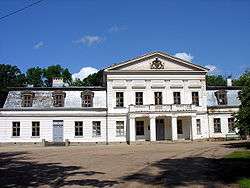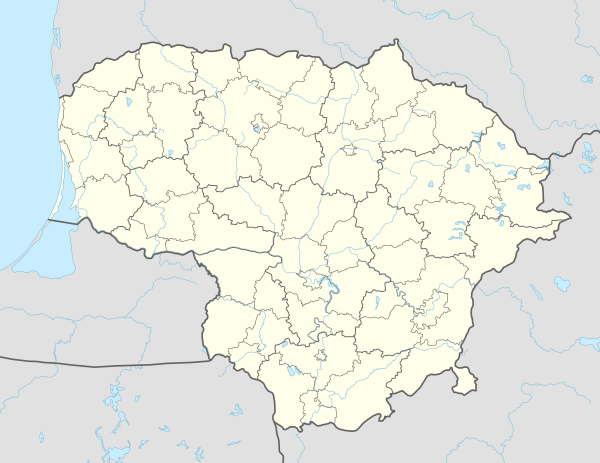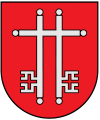Žagarė
| Žagarė | |||
|---|---|---|---|
| City | |||
 | |||
| |||
 Žagarė Location of Žagarė | |||
| Coordinates: 56°22′0″N 23°15′0″E / 56.36667°N 23.25000°ECoordinates: 56°22′0″N 23°15′0″E / 56.36667°N 23.25000°E | |||
| Country |
| ||
| Ethnographic region | Samogitia | ||
| County | Šiauliai County | ||
| Municipality | Joniškis district municipality | ||
| Eldership | Žagarė eldership | ||
| Capital of | Žagarė eldership | ||
| First mentioned | 1633 | ||
| Granted city rights | 1924 | ||
| Population (2005) | |||
| • Total | 2,028 | ||
| Time zone | UTC+2 (EET) | ||
| • Summer (DST) | UTC+3 (EEST) | ||
Žagarė (![]()
Etymology
Žagarė's name is probably derived from the Lithuanian word žagaras, meaning "twig". Other renderings of the name include: Latvian: Žagare, Polish: Żagory, Yiddish: זשאַגאַר, translit. Zhagar.[1]
History
The foundation of Žagarė dates back to the 12th century. It was an important centre of Semigallian warriors, who fought against the Livonian Brothers of the Sword and the Livonian Order. The cult of Barbora Žagarietė, servant of God, originated in the town in mid-1600s.
It long had a Jewish population that contributed to its culture. Yisroel Salanter (1810–1883), the father of the 19th-century Mussar movement in Orthodox Judaism, was born there. Isaak Kikoin (1908–1984), a renowned Soviet physicist, was also born there. During World War II and the German occupation, the Germans set up a Jewish ghetto in Žagarė, to hold Jews from Šiauliai Ghetto. In a massacre of the Einsatzgruppe A at the Yom Kippur on 2 October 1941 all Jews where cruely killed by the Lithuanian population at the marketplace and buried in Naryshkin Park. The blood was flowing to the Svete River and the Fire brigade had to wash it away.[2]
Today Žagarė is the administrative centre of the Žagarė Regional Park, known for its valuable urban and natural heritage.
Notable residents
- Louis Bookman
- Sidney Hillman
- Isaak Kikoin
- Phoebus Levene
- Paul Mandelstamm
- Yisroel Salanter
- Kalonimus Wolf Wissotzky. Founder of Wissotzky Tea
- Barbora Žagarietė
Nadine Gordimer's father Isidore Gordimer was a Jewish watchmaker from Žagarė.
References
- ↑ JewishGen Locality Page - Žagare, Lithuania
- ↑ Lipshitz, Leiba (2002). "The Šiauliai Ghetto, July 18, 1941–July 24, 1944". Šiaulių getas: kalinių sąrašai 1942. Vilna Gaon State Jewish Museum. ISBN 9955-9556-00.
Further reading
External links
| Wikimedia Commons has media related to Žagarė. |


